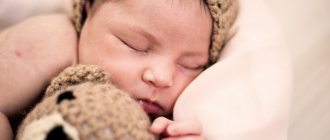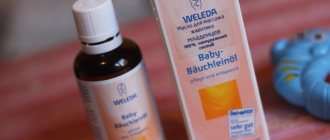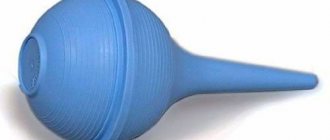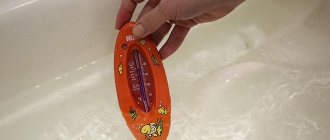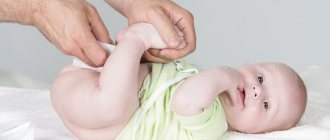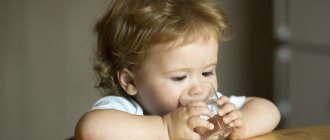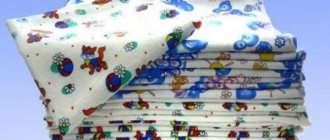Morning toilet of a newborn
Morning toileting for newborns is not just a symbolic process, but also a powerful obstacle to infection that can enter the child’s body from the outside. The skin of a newborn is more permeable to pathogenic microbes than that of adults, so you should always keep it clean.
Algorithm of actions for morning toileting of an infant
Every day the baby’s morning should begin with washing. Using a cotton swab, pre-moistened with boiled water, you need to gently wipe the baby's face with blotting movements. Using another cotton swab, wipe your eyes from the outer corner to the inner corner. Use a separate cotton pad for each eye. Then wipe the eyes with dry swabs.
Nose care
Next, roll flagella from cotton wool, soak them in boiled water or sterile vegetable oil and clean the baby’s nasal passages with gentle circular movements. Use a separate flagellum for each nostril.
Periodically, during the formation of crusts that complicate the child’s breathing, it is allowed to use special highly effective devices - suctions to cleanse the nasal sinuses. Do not use matches with cotton wool wrapped around them.
It is not recommended to use even cosmetic sticks to clean the nasal passages.
Intimate hygiene
The birth cavity of healthy babies does not need to be treated with anything. The child’s ear canals are cleaned no more than once a week with small cotton strands using the same method as the nose.
Then the child needs to be washed, and it doesn’t matter whether he had a bowel movement or not. To wash, use running water at a temperature of 36-37 degrees
Open the tap and adjust the water temperature, take the child in your left arm and place the lower part of his body under the running water. When washing, girls are held with their tummy up so that the water flows from the pubis to the anus.
Next, place the baby on a board or changing table and dry his skin with a napkin or soft diaper. Don't forget to work out the natural creases.
Treatment of skin folds in a newborn
The natural folds of the baby's body are lubricated with a cotton pad soaked in sterile vegetable oil or baby cream. It is also acceptable to use baby powder. You can only use one of the above options - combining the use of powder and oil is unacceptable.
The folds are lubricated, moving from top to bottom, in the following sequence:
- Behind the ears;
- On the neck;
- Axillary folds;
- Elbow folds;
- Folds near the hand (wrist);
- Popliteal folds;
- Folds near the foot (ankle);
- Inguinal folds;
- Folds in the buttocks area.
Caring for the navel and wound
Usually, a newborn is discharged home after the umbilical cord falls off, and therefore young mothers only have to treat the wound that remains in its place. In the first 2 weeks of life, in completely healthy babies, it may become wet. The umbilical wound can serve as a “gateway” for infection, so it requires special attention until it is completely healed.
To treat an umbilical wound you need:
- Sterile cotton swabs;
- 3% hydrogen peroxide solution;
- 1% alcohol solution of chlorophyllite (or 1% alcohol solution of green diamond);
- 70% ethyl alcohol solution.
Using the index finger and thumb of your left hand, you need to separate the edges of the umbilical wound and drop a few drops of a 3% peroxide solution onto it. Thoroughly “knead” the formed “foam” out of the wound with a clean cotton swab and then dry the wound with another one.
Use another sterile cotton swab with 70% ethyl alcohol and again, stretching the edges of the wound, treat them and the skin around the navel.
Using the fourth cotton swab dipped in a 1% chlorophyllite solution, treat the umbilical wound itself without touching the skin around it.
Any action in the process of performing the morning toilet should be accompanied by a gentle voice and a smile from the mother. In this case, the baby will perceive it as a game and a wonderful moment of communication with a loved one.
instructions: Morning toilet for a newborn.
The first month of the baby's life. Newborn care
Having crossed the threshold of the house with a precious snoring bundle in your arms, you are left alone with the baby.
The first 28 days of his life are considered the most important in the life of a newborn. And it is precisely these days that he becomes accustomed to the outside world and requires close attention. Not a single detail in his well-being or behavior should go unnoticed. Its further development and health depend on this. The child must be clean, well-fed and dry. Today we will talk about what kind of care a baby needs in the first month of life.
Morning toilet of a newborn
The morning toilet of a newborn begins with the treatment of the umbilical wound. Before treating the umbilical wound, you must wash your hands thoroughly with soap and only then can you begin to treat the umbilical wound. First, you need to carefully separate the edges of the umbilical wound and lubricate it with a cotton swab moistened with a solution of 3% hydrogen peroxide. If there is a lot of discharge and the stick becomes saturated with it, then a new stick is taken for further processing. If there are residual hydrogen peroxide in the wound, remove them with a clean, dry cotton swab. At the final stage, the wound is lubricated with a solution of brilliant green. The next stage in the morning toilet of a newborn is the toilet of the baby's eyes. For these purposes, use cotton pads moistened with boiled water at room temperature. Using a damp disc (separate for each eye), you carefully move it from the outer corner of the eye to the baby's nose. If your eyes fester, you can use chamomile decoction to wash them. Eye rinsing is carried out twice a day: in the morning immediately after the baby wakes up and before bedtime. The nasal openings are cleaned with cotton wool soaked in boiled water. To remove the crusts that sometimes form in a baby’s nose, first instill a saline solution into each nostril, which can be purchased without any problems at any pharmacy, and after 10-15 minutes, clean the nose with cotton wool. The cotton flagellum is inserted into the nasal cavity no more than 1 cm, using careful helical movements, while using one hand you “operate” the flagellum, and with the other you hold the baby’s head so as not to accidentally harm the baby. Next, wash the child’s face, neck and hands with boiled water using a cotton pad. The washed parts of the body are dried with a clean, soft towel, carefully touching the child’s skin using blotting movements. The morning toilet ends by washing the baby with warm boiled water under running water. Girls are washed from front to back so as not to introduce infection into the genitourinary organs. Dried folds of skin are lubricated with baby moisturizer and, if necessary, powdered with baby powder or talcum powder. This is where the morning toilet ends.
During the day, after each diaper change (every 3 hours) or bowel movement, the baby must be washed. Mommy performs all hygiene procedures with clean, thoroughly washed hands, having previously freed them from rings and watches. Your nails should be cut short and your skin should be free of hangnails.
Bathing a newborn
Daily bathing of newborns begins 1 day after the umbilical cord falls off, when the umbilical wound heals. Bathing water is not boiled; the air temperature in the room is maintained at 22-23 degrees Celsius. Fill the bath so that the child can be immersed in water up to the shoulders. You can add herbal decoctions (chamomile, celandine) and a weak solution of potassium permanganate to the water. The water temperature for swimming should be no more than 37.2. A small bath is convenient for bathing. Before each bath, wash the bath with a brush and soap. The water temperature is measured with a special thermometer. The baby is bathed with soap once or twice a week. We must ensure that water does not get into the baby’s eyes and ears. The duration of the bath is about 5 minutes. It is advisable to bathe your baby before the last feeding.
The article was prepared by the head of pediatric
department, pediatrician Varenik V.M.
How to wash a newborn baby
Why and why? The skin of babies is much more delicate than that of adults, irritation and diaper rash occur very easily, so you need to wash the baby every time after he has had a bowel movement. In addition, keeping the skin clean helps your baby develop the first skills of neatness.
If you are away from home, you can use special baby wipes instead of washing, but you should not completely replace washing with such a simplified skin treatment.
A little trick. Babies tend to have a bowel movement after or during each feeding. This leads to the conclusion that washing before eating is a thankless task.
The first thing you need to do is roll up your sleeves, remove rings and watches from your hands, adjust the temperature and pressure of running water. Prepare a thin diaper to dry the skin after washing. It is very convenient to just hang it on your shoulder and always have it at hand. Unwaddle your baby and remove his diaper. It is more comfortable to hold the baby with your left hand and wash it with your right. The boy is held face down when washing. Take the baby so that his chest lies across your forearm, while you hold his shoulder with the fingers of your left hand. Oddly enough, but hanging in this position, the baby does not experience the slightest discomfort. The girl needs to be washed only from front to back, so as not to contaminate her genitals. Place the child's back on the forearm of your hand, so that the head is on the bend of the elbow, and you will hold her left thigh with your fingers. This position allows you to securely hold the baby, and leaves you complete “freedom of action.” Wash your baby by scooping water into your palm using gentle movements from top to bottom, carefully removing dirt from the skin.
It is especially important to wash all skin folds where dirt can accumulate and cause irritation. Do not use soap unless absolutely necessary; washing with soap once a week is sufficient. When washing a girl, there is no need to “rub” the genitals, since the mucous membrane is very delicate
In addition, overzealous washing removes the protective lubricant that protects the genitals from pathogens. After washing, dry your baby's skin. First, wrap the diaper over your baby's lower body and transfer him to the changing table. Then thoroughly blot the genitals, groin, buttocks and popliteal folds. If necessary (irritation), treat skin folds with a small amount of baby oil. Your baby is happy with life again. Now it would be good to “air out the butt” for 5-10 minutes before putting on a new diaper.
Prevention of eye inflammation in a newborn
There are a large number of medications and folk recipes that help prevent eye problems in infants. Before using any product, consult your pediatrician.
Treatment with Furacilin
An antibacterial drug is the best friend of mothers and their babies. It is a product for external use and effectively fights staphylococci, streptococci, E. coli, etc. Sold in the form of tablets or ready-made solution. For newborn babies, it is recommended to use a pharmaceutical preparation, since it is sterile.
To prepare at home, take one tablet of the drug per 100 milliliters of water. Heat the liquid over low heat and bring to a boil. Add the crushed tablet and wait until it is completely dissolved. Strain the prepared product and wipe the eyes with sterile gauze. The maximum shelf life of the solution is one day.
| Furacilin cannot be used as a preventive measure; it is intended specifically to combat diseases, and not to prevent them. Rub your eyes twice a day until complete recovery. |
Saline solution for rinsing
It is a weak solution of sodium chloride at a concentration of 0.9%. Everyone is familiar with this drug from an early age; it is used for droppers, diluting medications and treating the epidermis. Sold in almost every pharmacy.
The product has several undeniable advantages:
- Democratic price
- Does not cause an allergic reaction,
- Sold ready-made
- Effectively fights pathogenic microorganisms.
In pharmacies it can be found in the form of a large bottle or small plastic ampoules. To treat your baby's eyes, a couple of drops are enough; apply them to a cotton pad and wipe. The result is noticeable within a few days. The solution is safe for a child’s health; it is often used to remove debris or dust that accidentally gets into the eyes.
Phytotherapy
Decoctions and infusions of herbs are recommended for use as aids in the fight against sepsis. It is worth remembering that traditional medicine is powerless against inflammation caused by blockage of the tear ducts. But herbal medicine is effective in treating conjunctivitis.
Tea compress
The most popular “grandmother’s” way of dealing with suppuration. Eye compresses are prepared from strong black tea. They relieve irritation and soothe the baby's delicate skin. To prepare the composition, follow the following instructions:
- Buy loose leaf black tea without flavoring additives,
- Brew a strong drink and cool it to room temperature, let it brew for half an hour,
- Strain the tea
- Soak cotton swabs in the liquid, wring them out and place them on your eyes. Leave for ten minutes.
Camomile tea
Chamomile infusion is an effective “fighter” against inflammatory processes. It can be used as a prophylactic to prevent souring and suppuration of the eyes. To prepare the infusion you will need:
- Take 4 tbsp. dry chamomile (can be purchased at any pharmacy) and pour a glass of boiling water,
- Leave for one hour for the flowers to infuse,
- Strain the liquid.
Treat your child's eyes in the morning and evening while washing.
Calendula decoction
The plant helps stop the development of purulent sepsis. To prepare the infusion you need:
- 1 tbsp. pour the flowers into a small saucepan and add 400 ml of water,
- Cook for ten minutes, bring to a boil,
- Strain the finished infusion and cool to room temperature.
The decoction is used to prepare compresses or as an eye wash.
Attention! Calendula can provoke an allergic reaction (in rare cases), so before the procedure, do a test to check the sensitivity of your baby's skin. Place a small amount of the product on the elbow, if there is no redness, the drug can be used
Bathing a newborn
Why and why? Bathing a newborn (hygienic bath) is carried out for all healthy children after the umbilical remnant falls off. Before the umbilical wound heals, it is recommended to bathe the baby in boiled water or running water, but you need to add a solution of potassium permanganate (potassium permanganate) to it.
Until your baby is six months old, it is advisable to bathe him daily; in the second half of his life, you can do this every other day. As a rule, children really like to swim, because before birth, water was their natural element. In water, the muscles relax, the child feels comfortable and calm. The duration of bathing in the first year of life is 5-10 minutes. Washing with soap is carried out no more than once a week. It is advisable to bathe the child no earlier than an hour after feeding, preferably 10-15 minutes before evening feeding.
It is more convenient to bathe a newborn baby together; most often, the father is called upon to help, and in many families, bathing the baby is exclusively the father’s “honorable mission.” Large and reliable male hands hold the baby’s tiny body with amazing tenderness, which contributes to the emergence and development of close contact between the child and the father, who at these moments feels very needed. But if you have to do without an assistant, don’t worry, you can do it just fine on your own.
Important! If your baby is unwell, has a fever or signs of skin irritation, it is better to postpone bathing until you consult your pediatrician.
You will need: a baby bath, a jug of warm water for rinsing the baby, a special water thermometer, baby soap, a terry mitten, a large terry towel, a diaper, baby oil, a changing table with prepared clothes for the baby, cotton swabs with limiters or cotton swabs.
If the umbilical wound has not yet healed, prepare two containers with cold and hot boiled water or a solution of potassium permanganate to add to running water. The solution of potassium permanganate must be added to the water “drop by drop” until the water turns a faint pink color. Before using potassium permanganate, make sure that the crystals are completely dissolved, as getting a potassium permanganate crystal on the skin can cause a burn.
The air temperature in the room while bathing the child should be 22-24 degrees. You can bathe your baby in the bathroom, if it is spacious enough, or in the kitchen.
- First of all, you need to prepare the bath - wash with a brush and soap and rinse with boiling water. Place the bath in a stable, comfortable position and fill it ½ full with water. First pour cold and then hot water to avoid steam formation. Now you need to immerse the thermometer in water. The temperature of the water in the bath should be 37-37.5 degrees. Measuring the water temperature with your elbow is only possible if you have sufficient experience; a thermometer is always more reliable.
- Lay out the baby's clothes on the changing table, lay a towel on top, and place a diaper on it for wiping. However, you can put the diaper near the bath to make it more convenient for you to take it.
- Undress the child and, if necessary, wash him. Take the baby so that the head rests on the forearm of your left hand, and hold the baby’s left shoulder joint with your fingers (the thumb clasps the shoulder from above, place the other fingers in the armpit). Use your right hand to support the baby's buttocks and legs.
- Slowly immerse the baby in the bath: first the buttocks, then the legs and torso. Continue to support the baby's head with your left hand, leaving your right hand free for washing. The water level should reach the baby's armpits.
- Swing the child on the water back and forth, left and right. Your movements should be smooth and unhurried. Smile at your baby and talk to him affectionately.
- If you plan to wash the child with soap, then the “mitten” is put on the right hand. Lather your body using gentle circular motions and immediately rinse the soaped areas. First, wash your head from the forehead to the back of the head, then your neck, arms, chest, abdomen, legs. Rinse skin folds thoroughly. Lastly, wash your buttocks and genitals.
- Remove the baby from the water with its back facing up. Rinse your body and wash your baby's face with water from a jug. Place a diaper on the baby, place him on the changing table, and dry the skin with gentle blotting movements.
- Dry your ears with cotton swabs or cotton swabs.
- Lubricate the folds of the skin with baby oil. If necessary, treat the umbilical wound.
- Swaddle or dress your baby.
Now, to feel complete happiness, it would be nice for your baby to eat and sleep.
Breastfeeding in the first month of life is carried out in a “free mode” - at the request of the child. In the future, the baby will set his own feeding schedule.
When caring for a child, the hands of the mother and other loved ones must be clean. It is necessary to observe the rules of personal hygiene. If catarrhal symptoms appear in the family, it is necessary to isolate the patient in a separate room. If the mother gets sick, breastfeeding is carried out wearing a medical mask.
CARE OF THE SKIN OF A NEWBORN AND PREVENTION OF SKIN DAMAGES.
When caring for the healthy skin of a newborn, you should avoid any actions that may disrupt the epidermal barrier (exposure to high humidity, friction, irritants, trauma). A decrease in the bactericidal properties of the skin is facilitated by degreasing (with alcohol), cooling, and irritation of the skin with urine and feces, leading to dilution of the water-lipid mantle of the epidermis.
The skin of newborns is more sensitive and permeable to various chemical agents than that of adults, so the risk of systemic poisoning is much higher.
It is recommended to bathe the child in warm water without adding any disinfectants; Daily use of shampoos, bubble baths and other detergents is not recommended.
Many powders contain particles that cause skin irritation, as well as fragrances that provoke allergic reactions. Talc-free powders can be used to treat the neck, armpit and groin folds of diaper rash due to irrational diaper use. It is necessary to avoid the widespread use of petroleum jelly (vegetable oil), which retains moisture and is an active allergen. Skin care products must be applied very carefully and not rubbed.
With improper skin care, diaper dermatitis occurs, which is irritation of the skin in the area in contact with the diaper. The main reason for the development of diaper dermatitis is defects in care (infrequent diaper changes, tight swaddling). Diaper dermatitis does not pose a serious threat to the baby's health, but the skin irritation is very painful, causing suffering and anxiety for the baby, which affects his well-being.
Regardless of the type of diapers (disposable or reusable), you must follow the rules for caring for your child:
- change the diaper when it is full;
- immediately change the diaper after the child defecates and then wash it (the girl should be washed in the direction from the genitals to the anus).
- use “breathable” diapers;
- organize air baths as often as possible during the day.
(Completely undress the baby, lay him on his tummy, perform simple massage techniques - stroking and gymnastics. All activities must be carried out before eating.)
Skin care is different when using disposable and reusable diapers.
When using disposable diapers, the skin should be dry; It is not recommended to use fatty ointments and creams that create a compress effect, which provokes the development of dermatitis. If ointment or cream is applied to the skin, excess product must be removed with a napkin before putting on the diaper. It is recommended to use water-based cream, lotions, and milk to care for the skin of a newborn.
When using reusable diapers, you can use creams and ointments, as creating a layer between the skin and the diaper reduces the risk of irritation.
CARE OF THE UMBILICAL CORD
According to international WHO recommendations, sterile conditions are not required to care for the umbilical cord.
The umbilical cord first dries out and mummifies when exposed to air, and then falls off. Each child has a different period of time for the umbilical cord to fall off - it depends on its thickness. It is believed that it should disappear before the 14th day of life.
It is not recommended to treat the umbilical cord residue with any antiseptics (solutions of aniline dyes, alcohol, potassium permanganate solution, etc.), it is enough to keep it dry and clean, protect it from contamination with urine, feces, as well as from injury when tightly swaddling or using disposable diapers with tight fixation. It has been proven that the local use of antiseptics not only does not reduce the frequency of infections, but also helps to delay the spontaneous shedding of the umbilical cord. In case of contamination, the umbilical cord and the skin around the umbilical ring can be washed with water and dried with clean cotton wool or gauze. Bathing is allowed in boiled water, followed by drying the remaining umbilical cord.
It is not recommended to use bandages or additional tying of the umbilical cord to speed up the mummification process.
Significantly reduces the incidence of purulent-inflammatory diseases of the umbilical wound by early discharge from the maternity hospital (2-4 days after birth), including before the umbilical cord falls off. Forcible removal (cutting off) of the umbilical cord is not recommended, since such a procedure is dangerous and can be complicated by bleeding, injury to the intestinal wall with an undiagnosed hernia of the umbilical cord, and infection. The effectiveness of the procedure has not been proven; forced removal of the umbilical cord should be recognized as an unjustified invasive intervention, potentially dangerous to the life of the newborn. It is possible for a newborn to be discharged home before the umbilical cord falls off.
SWADDING.
According to WHO recommendations, tight swaddling is not recommended, as it leads to undesirable consequences:
- blocking the movements of the diaphragm, making ventilation in the lungs difficult;
- impaired blood circulation in the extremities;
— hip dysplasia, especially when the child’s legs are rigidly fixed in the position of extension and adduction;
- reducing the air gap between the body and clothing, which impairs thermal insulation; increases the risk of both overheating and hypothermia;
— limitation of limb movements, which reduces the possibility of developing neuromuscular coordination;
- difficulty in properly attaching to the breast and breastfeeding (it is difficult for the child to open his mouth wide enough and turn his head), which reduces the likelihood of successful lactation.
It is preferable to dress the child in cotton clothing such as a “bodysuit” or loosely swaddling the lower part of the body, leaving the arms and head mobile.
BATHING.
Children under 6 months are bathed daily; older children can be bathed every other day. During the hot season, a child, regardless of age, needs to be bathed daily. For bathing, you must use a baby bath (use only for the child), pH-neutral baby soap, which is used 1-2 times a week. At the end of bathing with soap, the child should be doused with water, the temperature of which is 1 - 2 degrees lower than the water in the bath (a simple hardening method).
Tips for bathing your baby:
- You need to start bathing your child in boiled water until the umbilical ring heals - up to 1 month, then you can use non-boiled water.
- The water temperature for bathing should be 36 - 37 degrees (you must use a water thermometer), the room temperature should be at least 21 degrees (for premature babies - 24 degrees).
- Before bathing, it is recommended to lay the child naked on his stomach for a few minutes, massage and perform gymnastics.
- If your child has pooped, he needs to be washed before bathing.
- The child's stay in the water should be 5 - 10 minutes. The scalp of a child can be washed with baby soap or shampoo without tears in the direction from the forehead to the back of the head. Bathing a child's body with soap should be no more than 2 times a week.
- The face should be washed separately with clean water.
- After bathing, the child’s skin should not be wiped, but dried by “blotting” with a soft, warm diaper that absorbs moisture well.
- Your manipulations should bring only positive emotions to the baby.
You cannot bathe your child on the following days:
- loss of the remaining umbilical cord;
— vaccinations;
- increase in body temperature above 37.5
Bathing in herbs or using any other means should only be recommended by a doctor.
The selection of children's cosmetics is carried out on the recommendation of a doctor, taking into account the child's skin type.
CARE FOR EYES, NOSE, EARS, NAILS.
Toilet of the eyes and nose is carried out as needed:
- The eyes should be washed from the outer edge of the eye to the inner, each eye with a separate cotton swab moistened with boiled water.
- Nasal toileting is performed only when nasal congestion interferes with breastfeeding. This can be caused by a child regurgitating milk through the nose - “milk crusts” or very dry air form in the room where the child is. Before this manipulation, it is necessary to irrigate the nasal passages with an Aquamaris-type solution. You can make your own flagellum from cotton wool, moisten it with boiled water and use a twisting motion to clean the nasal passages one by one. Even if you are unable to properly clean your nose, you will cause the child to sneeze with this manipulation, with the help of which the baby will clean the nose himself. Frequent toileting of the nose can lead to swelling of the mucous membrane, since in babies the nasal mucosa is richly supplied with blood vessels.
The newborn's ear canal is not cleaned; only the ears are treated.
Nails can be trimmed after the baby is discharged from the maternity ward and has had a bath with soap. It is better to do this with children's scissors with rounded ends and it is more convenient while the child is sleeping. The nails on the handles should be left rounded, and on the legs – straight.
WALKS.
They begin on the recommendation of a doctor and are preferably carried out daily.
In winter, you can walk with children at an air temperature of at least 10 degrees. Start with 15 – 20 minutes, gradually increasing the walking time (you need to focus on the child’s mood).
In the summer, you can walk with your baby immediately after discharge from the hospital, preferably in a forested area. Do not place your child in direct sunlight - this can lead to burns and overheating!
Clothing for a child is used according to the season and according to the principle: “How many layers is the mother wearing - plus one layer for the child.”
BABY CAR SEAT.
A baby cannot be transported in a car without a child car seat. Buying a car seat for children is an absolutely necessary action; it has been proven that child injuries in a traffic accident are reduced by 70% when using a restraint system.
In addition, child car seats can prevent bruises and damage in various situations, for example, when a car suddenly brakes or “jumps” on a speed bump, etc.
Memo for parents
Morning toileting causes stress in a child, but in order for the procedure to bring joy and calm to the baby, you need to know several important recommendations:
- Morning toilet should not be done on an empty stomach. The child must be well-fed, but this should not be done immediately after feeding. The best option is 30 minutes after eating.
- Hygiene procedures do not excite babies, especially the treatment of the sinuses, ears and eyes. To make the actions performed more enjoyable for the baby, parents need to sing a calm song or tell something interesting.
- The touches of adult hands should be gentle, light, soft. No sudden movements or screams are allowed, this can greatly frighten the baby.
- The most comfortable temperature in the room where morning toileting is carried out is from 21 to 23 degrees.
- After hygiene measures, a diaper is put on the lower part of the body, and a T-shirt or undershirt is put on the upper part. In this form, the child is placed in a crib for a while, only then fully dressed.
- You should not swaddle your baby too tightly, because in a clamped, non-physiological state, pathology in the development of joints may appear.
Daily care of the baby helps to prevent the development of various skin diseases in a timely manner and to do without any medications, because the morning toilet of a newborn is not only regular hygiene, it is also the prevention of pathological conditions.
The algorithm of actions is shown by the medical staff upon discharge from the maternity hospital; all procedures must be carried out correctly, and the baby must be examined thoroughly.
V. Algorithm for performing a simple medical service.
Preparation for the procedure:
- Introduce yourself to your mother, explain the purpose and course of the upcoming procedure, and obtain informed consent for it.
- Put on an apron, sanitize your hands, dry them, and put on gloves.
- Treat the changing table and apron with a disinfectant solution, and place a diaper on it.
Performing the procedure:
- Unwrap the baby and place him on the swaddle.
- Wipe your face with a cotton ball moistened with boiled water (from the bridge of the nose to the temples, from the corners of the mouth to the temples and chin, around the mouth and under the chin).
- Rinse your eyes with sterile cotton balls moistened with furacillin solution 1:5000 from the outer corner of the eye to the inner. Each eye is treated with a separate cotton ball. At home, eyes are treated with boiled water.
- If there are crusts in the nasal passages, remove them using cotton wool moistened with sterile vegetable oil. Each nasal passage is treated with a separate cotton ball.
- If necessary, clean the ear canal and pinna with dry cotton swabs, thicker and twisted more tightly (for the ear canal - a separate cotton swab).
- In case of defecation, wash the child with warm (36C) running water (for girls - from the pubis to the anus); Using gentle blotting movements, dry the skin with a diaper.
- Inspect the skin folds, treat them with balls of sterile oil in the following order: behind the ear, cervical, axillary, elbow, wrist, popliteal, ankle, inguinal, perineal.
- Open the child's mouth by pressing on the chin; examine the oral mucosa.
- Swaddle your baby. Place him in the crib on his side.
Purposes of application
Baby oils are universal:
- clean the nose and ears;
- remove crusts on the head;
- prevent and treat diaper rash after wearing diapers and in skin folds, relieve dry skin;
- facilitate massage.
Massage
Massage is a beneficial procedure for newborns. The mother establishes contact with the baby, at the same time the baby’s body relaxes and increased muscle tone disappears.
Baby massage
The most popular special means for these purposes are:
- "Eared Nanny";
- "Tender mother";
- "The world of childhood".
It is also permissible to apply Vaseline, peach or olive oil to the baby’s skin. These are products of natural origin that are well absorbed and moisturize the skin.
After swimming
After bathing, baby oil, cream, powder, lotion or milk are applied to the skin.
Comparison of the effects of products used after bathing
| Means | Action |
| Talc, powder | Prevention of heat rash and diaper rash. The skin becomes silky. First, talc is poured onto the palm of the parents, then the baby’s skin is treated with it. |
| Milk, lotion | Helps with flaking (especially on the palms and soles) and dry skin. The milk simultaneously moisturizes the skin and prevents moisture loss. |
| Baby cream | Excellent prevention against diaper rash. Creams with string and chamomile extracts perfectly soothe the skin. |
| Spray with panthenol | Helps in the fight against diaper rash and dry skin. |
| Oil | It is recommended to apply only when the skin is extremely dry. |
For dry skin
Baby bathing oil for dry skin helps restore the skin, saturates the skin with vitamins E and D, soothes and heals damaged skin. It should be applied immediately after bathing. Dry skin can be caused by improper care of your baby.
Rules:
- Do not bathe a newborn for more than 7-8 minutes;
- Do not wear one diaper for more than three hours, change immediately after defecation. Carry out air baths;
- Do not tear off the scabs on the baby's head under any circumstances - this will cause injury to the skin and increase the risk of infection.
Processing folds
Baby oil is an excellent product to soften the skin. It is very soft in the fold area. Treatment of folds is required every day.
For what purposes is the procedure carried out:
- prevent the appearance of diaper rash;
- to prevent skin from drying out;
- to clean hard-to-reach places from dirt and sweat;
- You can track the onset of an allergic reaction in time.
Oil is best suited for this procedure because it covers the skin with a film that protects it from the penetration of pathogenic microbes. The folds should be blotted carefully, without rubbing, so as not to cause irritation. At the end of the procedure, excess is removed with a napkin or cotton pad. Then the child is dressed in clean clothes, or the baby can be swaddled and put to rest.
